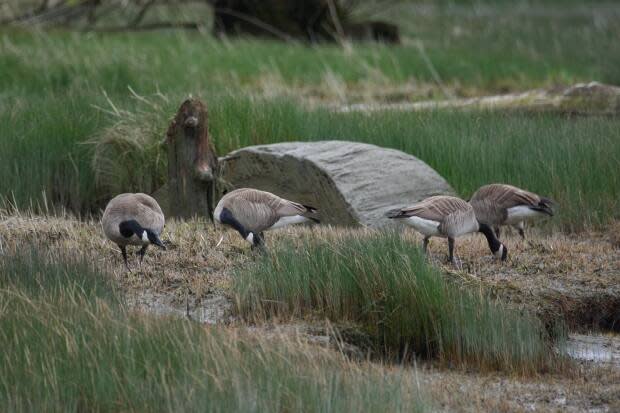National symbol or national pest? Abundant Canada geese populations a threat to ecosystems, research finds

A national symbol? Or a national pest?
For decades, Canada geese — known scientifically as Branta canadensis — have been recognized as emblematic of Canadian wildlife.
But the geese's population growth has consequences for essential ecosystems and at-risk species.
According to research out of the University of British Columbia, non-native Canada geese are overpopulating the banks of the Fraser River and consuming vegetation that is critical to the waterway's ecosystem and to salmon populations. It is estimated that there are at least seven million Canada Geese present in North America, according to the Canadian Wildlife Service.
Dominic Janus is studying the geese's impact on Lyngbye's Sedge, a grasslike plant that grows in wet ground.

"The habitat that [the sedge] provides is critical for juvenile salmon as they migrate down the Fraser River," he explained.
"These marshes are essentially the foundation of life. But this sedge now has an enemy."
LISTEN | Exploring our varied relationship with the Canada Goose
Canada Geese inhabiting the region are heavily grazing on the tidal marshes in the Fraser River estuary. Janus says the large bird's inefficient digestion causes it to consume large amounts of vegetation.
And the more they eat, the more evidence they leave behind.
"There's poo right next to the saddest looking stubs of sedges that I've ever seen," said Janus. "They don't have a chance at all."

The UBC masters candidate says salmon and other species living in the river that depend on the sedge are suffering because of the birds's overconsumption.
"We cannot look at this [with] only one lens. It really does involve us. We eat fish, there's fisheries, we harvest plants and animals."

'We thought it would be great'
Janus says the impacts of goose populations on local communities and economies can be traced back to settler colonialism and modern capitalism.
"We just brought [the geese] because we thought it would be great."
Historically, Canada Geese nested in some parts of southern Canada, particularly in open grassland areas with wetlands in southwestern Ontario and the southern Prairies.
Human activities like large-scale grain agriculture and urbanization have made food more readily available to them, and created urban habitats where geese are safe from predators and hunting.

It's resulted in what an American expert in natural resources and water quality describes as "explosions" of geese populations in areas we don't want them — and where they live for longer periods of time.
"Now because the climate change is creating warmer spaces, [the Canada goose is] wintering over as opposed to going further south for its winter ranges as the whole population is predicted to move further north," said Beth Clawson, state co-ordinator at Michigan State University's Kalamazoo County Extension.
But Janus is optimistic that the harms caused by abundant Canada goose populations can be fixed.
"I think this is going to create opportunities for us to restore habitats and create a better place for the fish, for the salmon to grow."


